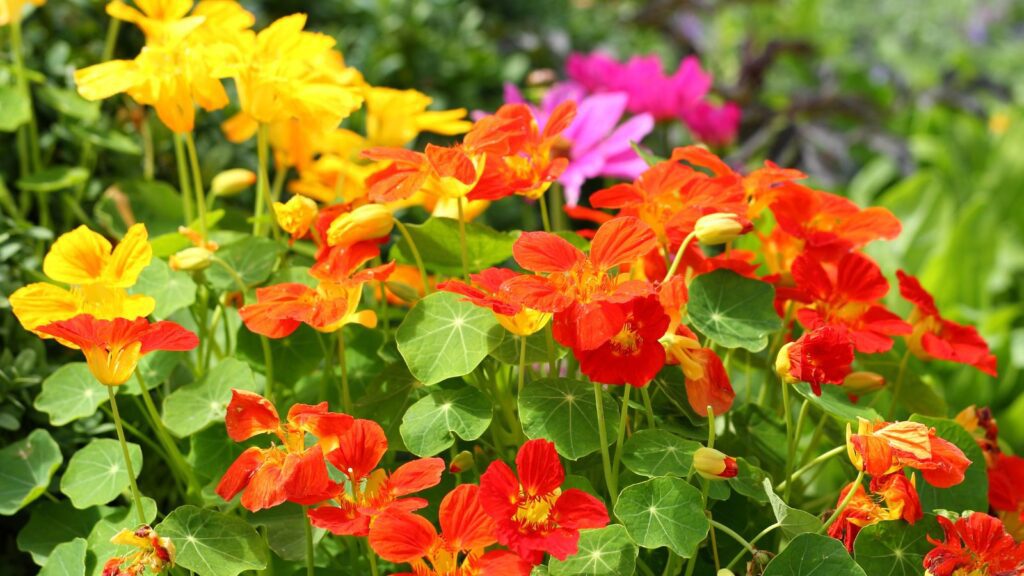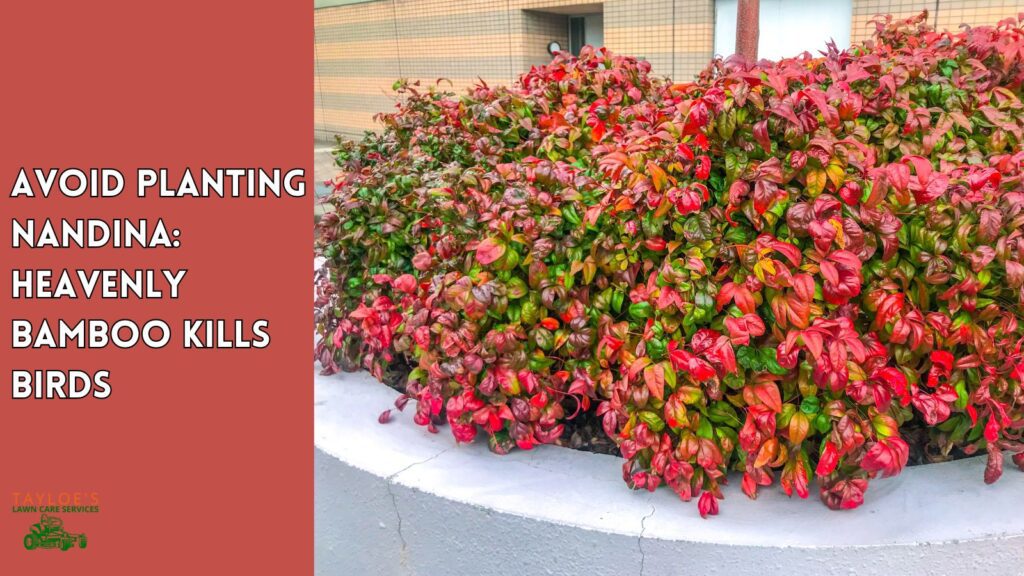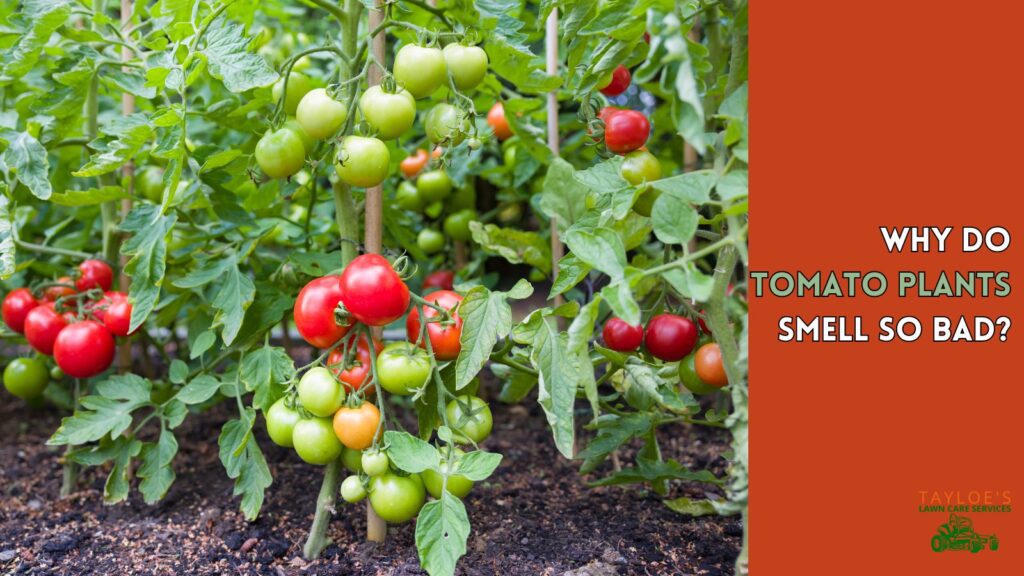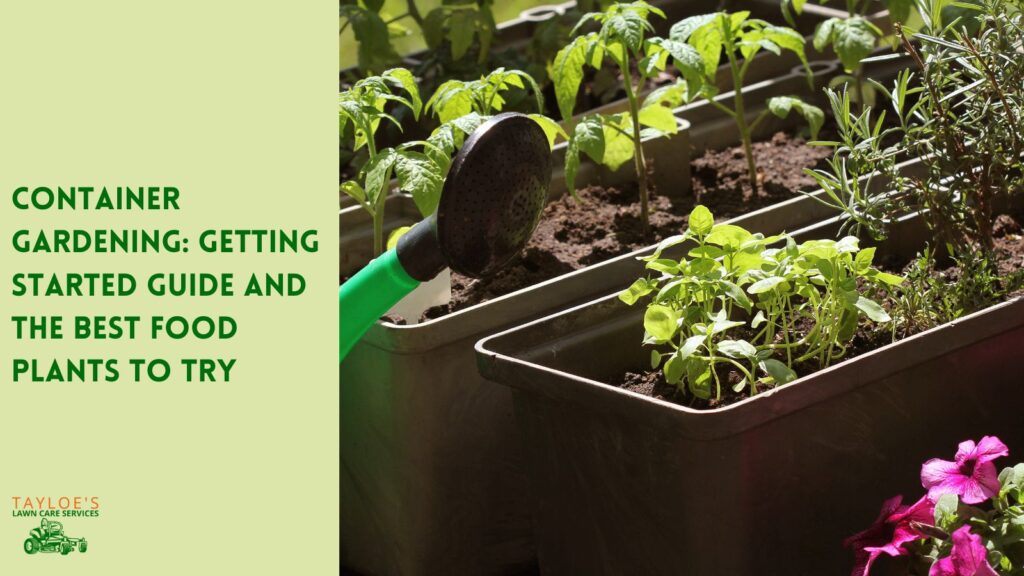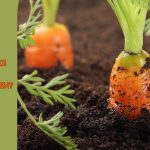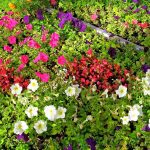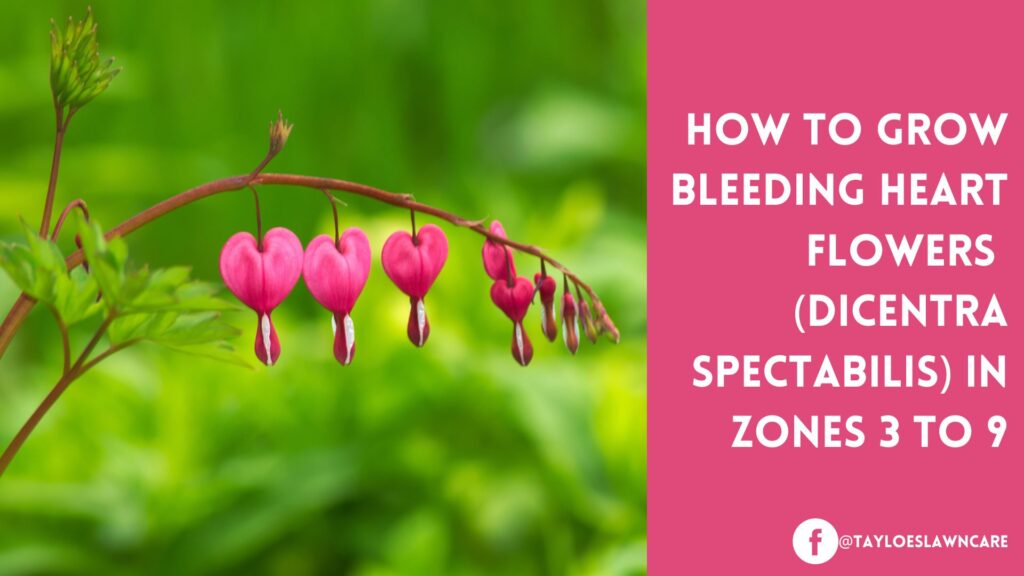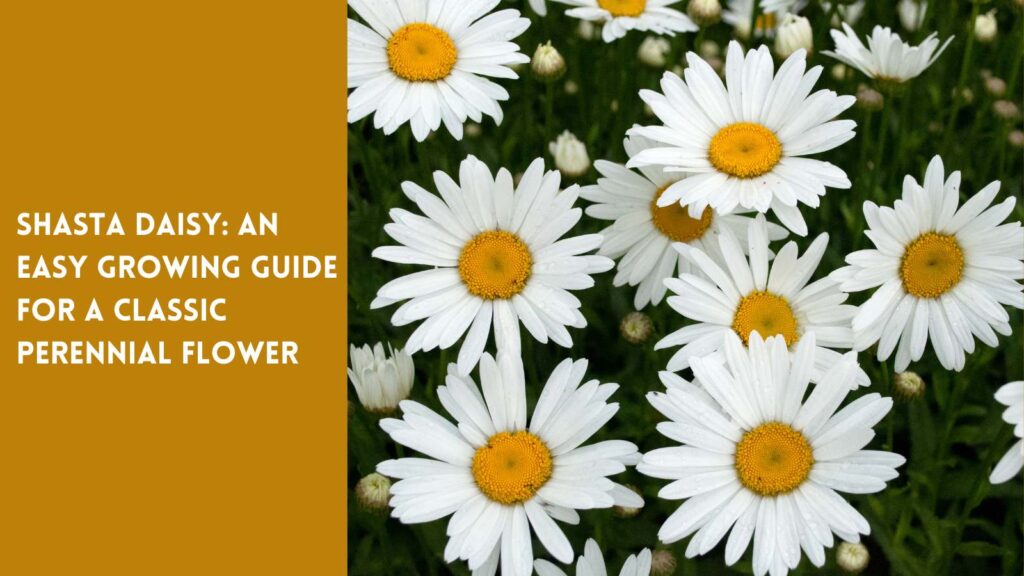Last Updated on: 9th February 2025, 08:00 am
Nasturtiums add early season color.
Nasturtium—it’s not just a plant. These flowers add a vibrant splash of color, a peppery addition to salads, and an easy-to-grow companion that brings both beauty and benefits to your garden.
With its bright, trumpet-shaped flowers and lush, shield-like leaves, this versatile plant is as ornamental as it is edible.
Thriving in sunny spots with well-draining soil, nasturtiums are perfect for novice gardeners and seasoned horticulturists alike.
Their propensity to attract beneficial pollinators while deterring garden pests makes them an excellent choice for integrated pest management.
Growing and caring for nasturtiums can be a rewarding endeavor, whether you’re looking to add a pop of color to your landscape or seeking a natural, peppery zest for your culinary creations.
This post’ll explore the ins and outs of cultivating these delightful blooms—from selecting the right variety to ensuring they flourish in your garden space.
Get ready to embrace the ease and charm of nasturtiums as we dive into the world of these enchanting edible flowers.
Nasturtium Plant Profile
| Common Name | Nasturtium |
| Botanical Name | Tropaeolum spp. |
| Plant Type | Annual, Perennial |
| Sun Exposure | Full Sun, Part Sun |
| Soil Type | Moist, well-drained |
| Soil pH | Slightly Acidic to Neutral |
| Mature Size | 1-3 feet wide and 1-10 feet tall |
| Bloom Time | Summer, Fall |
| Flower Color | Red, Orange, Yellow, White, Cream |
| Propagation | Seed, Stem Cuttings |
| Special Features | Low Maintenance, Good for Containers, Attracts Birds |
| Native Area | South America and Central America |
| Hardiness Zones | 9-11 (USDA) |
Now, why nasturtium when there is an array of other charming flowers to choose from?
The Benefits of Growing Nasturtium Flowers
Here is why these unparalleled garden all-rounders deserve a spot in your green space:
Effortless Elegance: Thrive with minimal fuss! Nasturtiums are the epitome of simplicity, flourishing without constant care, making them perfect for both green thumbs and gardening novices.
Culinary Delight: From peppery petals to tangy seeds, these edible wonders transform meals into culinary art, adding a splash of color and a burst of flavor to your favorite dishes.
Pest Control Allies: Nature’s own pest deterrent, these vibrant blooms keep the nibblers at bay, safeguarding your garden’s harmony without resorting to chemicals.
Pollinator Paradise: Bees and butterflies can’t resist their allure, making nasturtiums a buzzing hub of activity and a vital contributor to a thriving garden ecosystem.
Versatile Vibrance: Ground cover, trellis climber, or decorative garnish, they adapt to your garden vision with their stunning hues and diverse growth habits.
Eco-Friendly Guardians: Embrace the balance of nature by integrating nasturtiums into your space, promoting biodiversity, and encouraging ecological resilience.
Types of Nasturtiums
There are a multitude of nasturtium varieties to suit any garden design or culinary need. Here’s a glimpse into the types you might consider:
Trailing Varieties
Perfect for hanging baskets, cascading over walls, or as a vibrant ground cover, trailing nasturtiums can spread several feet to create a lush, colorful carpet or cascade.
Varieties like ‘Jewel of Africa’ or ‘Troika’ boast vines that can trail beautifully, offering a spectacular display of foliage and blooms.
Bush Varieties
Ideal for garden borders, pots, or as compact garden highlights, bush nasturtiums, such as ‘Alaska Mix’ or ‘Empress of India,’ maintain a more contained form.
They’re excellent for adding pops of color without overtaking the garden space.
Climbing Varieties
For vertical interest, climbing nasturtiums can adorn trellises, fences, or arbors.
Varieties like ‘Tall Climbing Mix’ can grow up to 10 feet, producing a vibrant show of flowers perfect for elevating your garden’s aesthetic.
Dwarf Varieties
If space is limited or you’re gardening in containers, dwarf varieties like ‘Tom Thumb’ or ‘Peach Melba’ are ideal.
They stay compact, making them perfect for balconies, small gardens, or as colorful edging plants.
Nasturtium Growing and Care Needs
Growing nasturtium is a straight-forward process, though there are a few key tips to ensure they thrive in your garden or container:
Planting Nasturtiums
Choosing a Site: For the best results, select a location where there is at least 6+ hours of direct sunlight daily. While nasturtiums can still grow in partial shade, receiving 3–6 hours of sunlight, they may not bloom as vigorously.
Ensure the soil offers good drainage and isn’t excessively fertile.
Soil Preparation: Loosen the soil to a depth of about 12 inches and mix in a light application of compost to improve drainage, especially if you have heavy soil.
Nasturtiums thrive in poorer soils–needing no extra fertilization unless your soil is severely malnourished.
Avoid high-nitrogen fertilizers, which can reduce flowering.
Sowing Seeds: You can start your nasturtiums indoors; however, direct sowing them outdoors works best as it helps the plants establish faster post-germination, ensuring a robust development and minimizing the risk of transplant stress.
Sow the seeds about 1/2 inch deep and 10 to 12 inches apart after the last spring frost, when the soil has warmed up to at least 55-65℉.
Gently (but thoroughly) water the area to settle the soil around the seeds. Until germination, ensure the soil stays moist but not waterlogged.
Germination should occur within 7-10 days.
If germinating indoors, start the seeds 2-4 weeks before your area’s last spring frost date, and consider using biodegradable pots to avoid disturbing the roots when transplanting.
Growing Nasturtiums
Watering: Once established, nasturtiums are relatively drought-tolerant but will produce more blooms with regular watering, especially during dry spells.
Avoid overwatering, as this can lead to fewer blooms, compromised flavor, and root rot.
Note: During the summer, nasturtiums might cease flowering due to heat stress, and their taste could intensify as well. Ensuring they receive adequate water can aid in alleviating the impact of high heat.
Feeding: These plants are light feeders and do not require frequent fertilization. Over-fertilizing can lead to abundant leaves but fewer blooms.. If your soil is very poor, a light feeding with a balanced, low-nitrogen fertilizer or compost tea during the growing season can help.
Support for Climbing Varieties: Provide support structures like trellises or fences for climbing nasturtium varieties to encourage vertical growth.
Caring for Nasturtium Plants
Deadheading: While not necessary, removing spent flowers can promote more blooms and extend the flowering period.
If growing your nasturtiums in containers, consider trimming them back periodically over the growing season to encourage new foliage.
Temperature and Humidity: Nasturtiums are quite adaptable to various temperature ranges but thrive best in cooler conditions. They can handle warm days but prefer cooler nighttime temperatures to maintain their vibrant blooms.
High humidity combined with extreme heat can stress the plants, sometimes leading to fewer flowers or leaf problems.
In very hot climates, provide some afternoon shade to help protect the plants from heat stress and keep them blooming longer.
Pest Management: Nasturtiums are known to repel certain pests naturally. However, they can attract aphids. Keep an eye out for these pests and manage them with water sprays or insecticidal soap if they become problematic.
Disease Prevention: Ensure adequate air circulation around your plants to prevent fungal diseases. Also, avoid top-down watering to reduce leaf wetness.
Harvesting
Harvest the flowers and leaves as needed throughout the growing season. Do it in the cool of the morning, after the dew has dried but before the sun is at its strongest–to ensure the best flavor and longevity of your harvest.
For the seed pods, collect just before the seeds mature and harden unless you plan to save them for replanting.
If so, allow the seed pods to fully mature on the plant, then collect the chick-pea-sized seeds after they dry and fall off.
Clean, dry, and store them in a paper envelope in a cool, dark place for next season’s planting.
Propagating Nasturtium
Nasturtiums are primarily propagated through seeds, which can be directly sown into the garden soil or started indoors. For propagation through stem cuttings:
- Select a healthy stem and snip a 4-6 inch piece just beneath a leaf joint.
- Remove the lower leaves and place the cutting in a glass of water or a moist soil mix.
- Keep the medium moist and in a warm, bright spot but out of direct sunlight.
- Roots should develop within a couple of weeks, after which the cutting can be transplanted into the garden or a pot.
Companion Planting
Nasturtium plants make excellent companions for vegetable and fruit gardens, as they can repel a variety of pests and attract beneficial insects.
Plant them near tomatoes, cucumbers, kale, and radishes for a healthier, more vibrant garden.
End-of-Season Nasturtium Care
Nasturtiums are annuals in most climates, so they’ll die back with the first frost. You can collect seeds from the dried seed pods to plant next year.
In USDA zones 9-11, they may survive as perennials; cut them back in late fall to encourage new growth in spring.
Getting Creative with Your Nasturtium (Culinary Uses and Recipes)
These “goldies” are a do-it-all; a feast for the eyes yet a delight for the palate.
Every part of nasturtium is edible, with a peppery flavor similar to arugula or watercress.
The flowers make a stunning edible garnish, while the leaves can be chopped and added to salads, sandwiches, or pesto for a spicy kick.
The immature seed pods can be pickled to make “poor man’s capers.”
Below are a few recipe suggestions to spark your culinary creativity:
- Salads: Add a peppery zest to your salads by tossing in some nasturtium leaves and flowers. They offer a burst of color and a spicy kick that complements any green salad.
- Sandwiches and Wraps: Use the leaves as a spicy alternative to lettuce or add the flowers for a decorative touch that packs flavor.
- Nasturtium Butter: Blend softened butter with chopped nasturtium flowers for a colorful, flavorful spread that’s perfect on fresh bread or steamed vegetables.
- Stuffed Nasturtium Flowers: Mix cream cheese, herbs, and a bit of lemon zest, then gently stuff the mixture into nasturtium flowers for a beautiful, edible appetizer.
- Pickled Seed Pods: The unripe seed pods can be pickled to create a caper-like garnish, perfect for adding zest to a variety of dishes.
Just keep in mind that the intensity of the flavor can vary, so taste as you go!
Answering Your Nasturtium FAQs
How do you keep nasturtiums happy?
Ensure they bask in ample sunlight, receive moderate watering, and grow in poor to average soil without extra fertilizers; this encourages their characteristic lush foliage and vivid flowers.
Should I soak nasturtium seeds before planting?
Soaking the seeds overnight can expedite germination, but it’s optional; either way, plant them in well-drained soil after the last frost for a burst of summer color.
How long do nasturtiums last?
As annuals, nasturtiums’ spectacular show lasts from spring until frost, though in milder climates, they may curtain call as perennials, ready to dazzle year after year.
Why won’t my nasturtiums grow?
Stunted growth often stems from too little sun, soggy or poor soil, or planting too deep. Ensure they’re bathed in light, the soil drains well, and you’re not burying their potential.
Can nasturtiums grow in pots?
Absolutely, nasturtiums adapt beautifully to pot life, provided they have drainage holes, quality potting mix, and a sunny perch to soak up the rays.
There you go!
Armed with…
Everything You Need to Grow and Care for Nasturtium Flowers Successfully
It’s now time to start planting!
These low-maintenance, versatile plants are ready to brighten your garden and plate.
So, why wait?
Begin your nasturtium journey today and enjoy the vibrant blooms and unique flavors they bring.
Author Profile

- Maureen Abuor
- Maureen Abuor is a professional content marketing strategist and SEO strategist, with particular knowlege of creating landscaping and gardening content that informs and delights her audience. When she's not working, she's a busy mother of three precious little ones and child of God.
Latest entries
 Lawn CareApril 29, 2025Best shady area grass seed for Eastern NC
Lawn CareApril 29, 2025Best shady area grass seed for Eastern NC GardeningApril 15, 2025How do I make organic soil for the garden?
GardeningApril 15, 2025How do I make organic soil for the garden? Flower GardenMarch 7, 2025What are wave petunias?
Flower GardenMarch 7, 2025What are wave petunias? Flower GardenMarch 3, 202520 Full-sun annuals for your spring and summer garden
Flower GardenMarch 3, 202520 Full-sun annuals for your spring and summer garden

